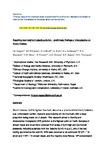Reaching New Heights in Plastic Pollution—Preliminary Findings of Microplastics on Mount Everest
| dc.contributor.author | Napper, IE | |
| dc.contributor.author | Davies, Bede Ffinian Rowe | |
| dc.contributor.author | Clifford, H | |
| dc.contributor.author | Elvin, S | |
| dc.contributor.author | Koldewey, HJ | |
| dc.contributor.author | Mayewski, PA | |
| dc.contributor.author | Miner, KR | |
| dc.contributor.author | Potocki, M | |
| dc.contributor.author | Elmore, AC | |
| dc.contributor.author | Gajurel, AP | |
| dc.contributor.author | Thompson, Richard | |
| dc.date.accessioned | 2021-08-20T13:27:20Z | |
| dc.date.available | 2021-08-20T13:27:20Z | |
| dc.date.issued | 2020-11-20 | |
| dc.identifier.issn | 2590-3322 | |
| dc.identifier.issn | 2590-3322 | |
| dc.identifier.uri | http://hdl.handle.net/10026.1/17619 | |
| dc.description | File replaced (incorrect version) on 16/9/2022 by KT (LDS). | |
| dc.description.abstract |
Mount Everest was once a pristine environment. However, due to increased tourism, waste is accumulating on the mountain, with a large proportion being made of plastic. This research aimed to identify and characterize microplastic (MP) pollution near the top of highest mountain on Earth and could illustrate the implications for the environment and the people living below. Stream water and snow were collected from multiple locations leading up to, and including, the Balcony (8,440 m.a.s.l). MPs were detected at an ~30 MP L−1 in snow and ~1 MP L−1 in stream water, and the majority were fibrous. Therefore, with increased tourism, deposition of MP near Mt. Everest is expected to rise. At a pivotal point in the exploration of remote areas, environmental stewardship should focus on technological and other advances toward minimizing sources of MP pollution. Plastic pollution is a key issue of our time, with the environmental impacts of this remarkable material increasingly the focus of interventions ranging from grassroots clean-up initiatives to product re-design and international policies. In this paper, we provide the first documentation of the likely presence of microplastics in snow and stream water on Mt. Everest, including near regions of high human presence, such as near climbing paths. These tiny plastic pieces (<5 mm) were mainly polyester fibers, likely coming from climber's clothing and equipment. These findings highlight human impacts in Earth's remotest areas, partly through the act of exploration of extreme environments. This creates a challenge and opportunity for manufacturers of performance clothing and equipment to develop designs that use more sustainable materials that are either natural or minimize shedding of microplastics. Climbers and trekkers should consider the full impact of exploration activities on the environment. An analysis of snow and stream water on Mt. Everest up to 8,440 m.a.s.l. found microplastics (<5 mm) that were more concentrated near high human presence. Most of these microplastics were polyester fibers, likely to come from clothing and equipment. Exploration of extreme, remote environments requires appropriate stewardship, including progressing technological advances in gear design and minimising specific sources of plastic pollution. | |
| dc.format.extent | 621-630 | |
| dc.language | en | |
| dc.language.iso | en | |
| dc.publisher | Elsevier BV | |
| dc.title | Reaching New Heights in Plastic Pollution—Preliminary Findings of Microplastics on Mount Everest | |
| dc.type | journal-article | |
| dc.type | Journal Article | |
| plymouth.author-url | https://www.webofscience.com/api/gateway?GWVersion=2&SrcApp=PARTNER_APP&SrcAuth=LinksAMR&KeyUT=WOS:000646432300018&DestLinkType=FullRecord&DestApp=ALL_WOS&UsrCustomerID=11bb513d99f797142bcfeffcc58ea008 | |
| plymouth.issue | 5 | |
| plymouth.volume | 3 | |
| plymouth.publication-status | Published | |
| plymouth.journal | One Earth | |
| dc.identifier.doi | 10.1016/j.oneear.2020.10.020 | |
| plymouth.organisational-group | /Plymouth | |
| plymouth.organisational-group | /Plymouth/Faculty of Science and Engineering | |
| plymouth.organisational-group | /Plymouth/Faculty of Science and Engineering/School of Biological and Marine Sciences | |
| plymouth.organisational-group | /Plymouth/REF 2021 Researchers by UoA | |
| plymouth.organisational-group | /Plymouth/REF 2021 Researchers by UoA/UoA07 Earth Systems and Environmental Sciences | |
| plymouth.organisational-group | /Plymouth/Research Groups | |
| plymouth.organisational-group | /Plymouth/Research Groups/Marine Institute | |
| plymouth.organisational-group | /Plymouth/Users by role | |
| plymouth.organisational-group | /Plymouth/Users by role/Academics | |
| plymouth.organisational-group | /Plymouth/Users by role/Researchers in ResearchFish submission | |
| dcterms.dateAccepted | 2020-10-21 | |
| dc.rights.embargodate | 2021-8-25 | |
| dc.identifier.eissn | 2590-3322 | |
| dc.rights.embargoperiod | Not known | |
| rioxxterms.versionofrecord | 10.1016/j.oneear.2020.10.020 | |
| rioxxterms.licenseref.uri | http://www.rioxx.net/licenses/all-rights-reserved | |
| rioxxterms.licenseref.startdate | 2020-11-20 | |
| rioxxterms.type | Journal Article/Review |


